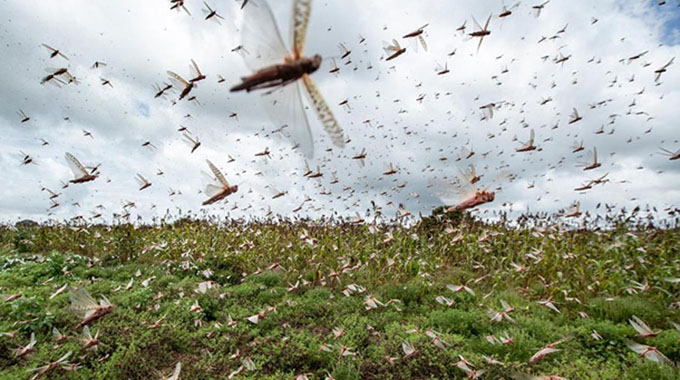Locust surveillance, control begins
The Herald
2/12/2021

Sifelani Tsiko
Agric, Environment & Innovations Editor
The Plant Protection Research Institute has started conducting locust surveillance and control actions to ensure crops are protected from pest outbreaks in the 2021 -2022 farming season which is expected to have above normal rains.
Head of the institute, Shingirayi Nyamutukwa told the Herald yesterday that the Ministry of Lands, Agriculture, Fisheries, Water and Rural Development had mobilised resources in partnership with the Food and Agriculture Organisation of the United Nations to monitor and forecast outbreaks.
“As farmers prepare their fields and plant various crops, we anticipate that we may experience pest outbreaks that may wipe out their crops impacting on farmers’ livelihoods, income earnings, food and nutritional security at national level,” he said.
“We have set up at least 132 African armyworm traps in six provinces namely Mashonaland Central, Mashonaland East, Mashonaland West, Manicaland, Midlands and Masvingo to help us forecast and monitor locust outbreaks.”
The institute was targeting to monitor the African armyworms (Spodoptera exempta) and the African Migratory Locusts (Locusta migratoria migratoroides) in the country’s six major cereal producing provinces.
Zimbabwe usually experiences outbreaks of the African armyworm as a result of moths that are brought in through winds that bring rains into the country during the summer cropping season.
“The traps provide information on the presence of the moths well in time before damage is caused. This allows time for the institute to direct chemicals to areas that are likely to experience outbreaks based on the results of the Early Warning System,” Nyamutukwa said.
Currently, he said, a total of 66 members drawn from the Plant Protection Institute, Plant Quarantine Services and AGRITEX were being trained in Mutare, Masvingo and Bulawayo on the eLocust3m tool that is used in collecting information on locust situations and monitoring the pest at regional level.
The training which also covered locust identification, biology and management was being funded by the FAO Zimbabwe office and the USAID.
The institute has also received equipment and vehicles to help it in its locust surveillance and control programmes.
“We are very grateful for the support we have received. It will help us a lot to carry out our surveillance and control programmes in breeding grounds which are in remote parts of the country,” Nyamutukwa said.
“We now have the capacity to handle outbreaks. All this will help ensure food and nutrition security in the country and help the nation to attain its goals enshrined in our National Development Strategy 1 as well as Vision 2030.”
Zimbabwe last experienced a serious African armyworm outbreak in the 2019 – 2020 farming season.
“Outbreaks are not experienced in all the years. However, with the anticipated good farming season, the African armyworm outbreaks cannot be ruled out as we have already started to receive trap catches of the pest in areas like Henderson and Shamva (Mashonaland Central) and Murombedzi and Magunje (Mashonaland West),” Nyamutukwa said.
In March this year, the Plant Protection Research Institute detected an outbreak of three indigenous species which do not spread over long distances unlike the African migratory locust.
The three types of locust species that were identified included — the Ruspolia differens, commonly known as “madhumbudya,” the Cytacanthacris (green locusts) and the Cataloipus oberthuli known locally as ‘njeru’ which are all edible.”
The most affected areas were Chiredzi wards 1- 12 and 22 where more than 2 457 households had their crops damaged while in Mwenezi some 2 440 households in BJB, Chikokoto and Masangula. The locust caused serious damage to sorghum, millet, maize and pastures. Armoured crickets also caused serious damage too.
Last year, locust outbreaks in Zimbabwe, Botswana, Namibia and Zambia were controlled. Heavy rains created conducive conditions for swarms to breed in these countries forcing plant protection agencies to take steps to control any outbreaks.
